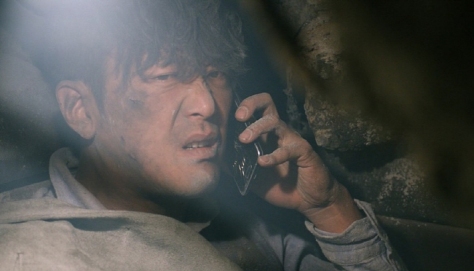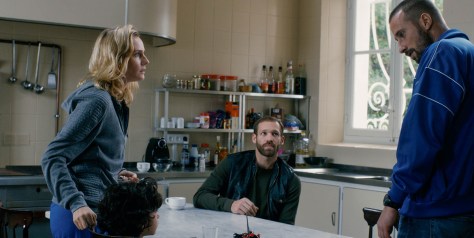By Dennis Hartley
(Originally posted on Digby’s Hullabaloo on December 31, 2016)

It’s hard to believe it’s been 10 years since my pal Digby graciously offered me a crayon, a sippy cup and a weekly play date on her otherwise grownup site so I can scribble about pop culture. I’d like to take this opportunity to thank everybody who continues to support Hullabaloo and wish you and yours the best in 2017! ‘Tis the season to do a year-end roundup of the best films I reviewed in 2016. Alphabetically, not in order of preference:
The Curve – It’s tempting to synopsize Rifqi Assaf’s road movie as “Little Miss Sunshine in the Arabian Desert” but that would be shortchanging this humanistic, warmly compassionate study of life in the modern Arab world. It’s essentially a three-character chamber piece, set in a VW van as it traverses desolate stretches of Jordan. Fate and circumstance unite a taciturn Palestinian who has been living in his van, with a chatty Palestinian divorcee returning to a Syrian refugee camp and an exiled Lebanese TV director. A beautifully directed and acted treatise on the commonalities that defy borders. (Full review)
Eat That Question – If there’s a missing link between today’s creative types who risk persecution in the (virtual) court of public opinion for the sake of their art, and Lenny Bruce’s battles in the actual courts for the right to even continue practicing his art, I would nominate composer-musician-producer-actor-satirist-provocateur Frank Zappa, who is profiled in Thorsten Schutte’s documentary. Admittedly, the film plays best for members of the choir. If you’ve never been a fan, the largely non-contextualized pastiche of vintage clips will likely do little to win you over. Still, if you’re patient enough to observe, and absorb, the impressionistic approach manages to paint a compelling portrait. (Full review)
Hail, Caesar! – Truth be told, the narrative is actually a bit thin in this fluffier-than-usual Coen Brothers outing; it’s primarily a skeleton around which they are able to construct a portmanteau of 50s movie parodies. That said, there is another level to the film, one which (similar to the 2015 film Trumbo) depicts the Red Scare-induced fear and paranoia that permeated the movie industry in the 1950s through the eyes of a slightly fictionalized real-life participant (in this case, a Hollywood “fixer” played by Josh Brolin). George Clooney hams it up as a dim-witted leading man who gets snatched off the set of his latest picture (a sword-and-sandal epic bearing a striking resemblance to Spartacus) by an enigmatic organization called The Future (don’t ask). It’s supremely silly, yet enjoyable. (Full review)
Home Care – The “Kubler-Ross Model” postulates that there are five distinct emotional stages humans experience when brought face-to-face with mortality: denial, anger, bargaining, depression, and acceptance. All five are served up with a side of compassion, a dash of low-key anarchy and a large orange soda in this touching dramedy from Czech director Slavek Horak. An empathic, sunny-side-up Moravian home care nurse (Alena Mihulova) is so oriented to taking care of others that when the time comes to deal with her own health crisis, she’s stymied. A deft blend of family melodrama with gentle social satire. Mihulova and Boleslav Polivka (as her husband) make an endearing screen couple. (Full review)
Jackie – Who among us (old enough to remember) hasn’t speculated on what it must have been like to be inside Jacqueline Kennedy’s head on November 22, 1963? Pablo Larrain’s film fearlessly wades right inside its protagonist’s psyche, fueled by a precisely measured, career-best performance from Natalie Portman in the titular role, and framed by a (fictional) interview session that the recently widowed Jackie has granted to a probing yet acquiescing journalist (Billy Crudup), which serves as the convenient launching platform for a series of flashbacks and flash-forwards. The narrative (and crucially, Portman’s performance) is largely internalized; resulting in a film that is more meditative, impressionistic and personalized than your standard-issue historical drama. The question of “why now?” might arise, to which I say (paraphrasing JFK)…“why not?” (Full review)
Mekko – Director Sterlin Harjo’s tough, lean, neorealist character study takes place in Tulsa, Oklahoma. Rod Rondeaux (Meek’s Cutoff) is outstanding as the eponymous character, a Muscogee Indian who gets out of jail after 19 years of hard time. Bereft of funds and family support, he finds tenuous shelter among the rough-and-tumble “street chief” community of homeless Native Americans as he sorts out how he’s going to get back on his feet. Harjo coaxes naturalistic performances from all. There’s more here than meets the eye, with subtexts about Native American identity, assimilation and spirituality. (Full review)
Older Than Ireland – “They” say with age, comes wisdom. Just don’t ask a centenarian to impart any, because they are likely to smack you. Not that there is any violence in Alex Fegan and Garry Walsh’s doc, but there is a consensus among interviewees (aged from 100-113 years) that the question they find most irksome is: “What’s your secret to living so long?” Once that hurdle is cleared, Fegan and Walsh’s subjects have much to impart in this wonderfully entertaining (and ultimately moving) pastiche of the human experience. Do yourself a favor: turn off your personal devices for 80 minutes, watch this wondrous film and plug into humankind’s forgotten backup system: the Oral Tradition. (Full review)
Snowden – Oliver Stone had a tough act to follow (Laura Poitras’ Oscar-winning 2014 documentary, Citizenfour) when he tackled his biopic about Edgar Snowden, the former National Security Agency subcontractor who ignited an international political firestorm (and became a wanted fugitive) when he leaked top secret information to The Guardian back in 2013 regarding certain NSA surveillance practices, but he pulls it off quite well. This is actually a surprisingly restrained dramatization by Stone, which is not to say it is a weak one. In fact, quite the contrary-this time out, Stone had no need to take a magical trip to the wrong side of the wardrobe. That’s because the Orwellian machinations (casually conducted on a daily basis by our government) that came to light after Snowden lifted up the rock are beyond the most feverish imaginings of the tin foil hat society. Stylistically speaking, the film recalls cerebral cold war thrillers from the 1960s like The Spy Who Came in From the Cold, with a nuanced performance by Joseph Gordon-Levitt. (Full review)
The Tunnel– Kim Seong-hun’s film is a (no pun intended) cracking good disaster thriller from South Korea, concerning a harried Everyman (Ha Jung-woo) who gets trapped in his car when a mountain tunnel collapses on top of him. Now, I should make it clear that this is not a Hollywood-style disaster thriller, a la Roland Emmerich. That said, it does have thrills, and spectacle, but not at the expense of its humanity. This, combined with emphasis on characterization, makes it the antithesis of formulaic big-budget disaster flicks (typically agog with CGI yet bereft of IQ). There’s more than meets the eye here; much akin to Billy Wilder’s Ace in the Hole, Seong-hun uses the “big carnival” allusions of the mise-en-scene outside the tunnel to commentate on how members of the media and the political establishment share an alchemist’s knack for turning calamity into capital. Full review)
Weiner – Co-directors Josh Kriegman and Elyse Steinberg were given remarkable access to Anthony Weiner, his family and campaign staffers during the course of his ill-fated 2013 N.Y.C. mayoral run. Their no-holds-barred film raises many interesting questions prompted in the wake of the former congressman’s “sexting” scandal (which led to his resignation from the U.S. House of Representatives in 2011)…the most obvious one being: should ‘we’ be willing to forgive personal indiscretions (barring actual criminal offenses) of those we have voted into office? After all, if making boneheaded decisions in one’s love life was a crime, there would be barely enough politicians left outside of prison to run the country. Then there’s this chestnut: WTF were you thinking?! If you’re curious to see the film because you think it answers that one, don’t waste your time. However, if you want to see an uncompromising, refreshingly honest documentary about how down and dirty campaigns can get for those in the trenches, this is a must-see. (Full review)
# # #
And these were my “top 10” picks for each of the years since I began writing film reviews over at Digby’s Hullabaloo (you may want to bookmark this post as a handy quick reference for movie night).
[Click on title for full review]
2007
Eastern Promises, The Hoax, In the Shadow of the Moon, Kurt Cobain: About a Son, Michael Clayton, My Best Friend, No Country for Old Men, Pan’s Labyrinth, Paprika, Zodiac
2008
Burn After Reading, The Dark Knight, The Gits, Happy Go Lucky, Honeydripper, Man on Wire, Milk, Slumdog Millionaire, Vicky Cristina Barcelona, The Visitor
2009
The Baader Meinhof Complex, Inglourious Basterds, In the Loop, The Limits of Control, The Messenger, A Serious Man, Sin Nombre, Star Trek, Where the Wild Things Are, The Yes Men Fix the World
2010
Creation, Inside Job, Joan Rivers: A Piece of Work, Little Big Soldier, A Matter of Size, My Dog Tulip, Nowhere Boy, Oceans, The Runaways, Son of Babylon
2011
Another Earth, Certified Copy, The Descendants, Drei, Drive, The First Grader, Midnight in Paris, Summer Wars, Tinker/Tailor/Soldier/Spy, The Trip
2012
Applause, Dark Horse, Killer Joe, The Master, Paul Williams: Still Alive, Rampart, Samsara, Skyfall, The Story of Film: an Odyssey, Your Sister’s Sister
2013
The Act of Killing, Big Star: Nothing Can Hurt Me, Computer Chess, 56 Up, The Hunt, Mud, The Rocket, The Silence, The Sweeney, Upstream Color
2014
Birdman, Child’s Pose, A Coffee in Berlin, The Grand Budapest Hotel, Kill the Messenger, The Last Days of Vietnam, Life Itself, A Summer’s Tale, The Wind Rises, The Theory of Everything
2015
Chappie, Fassbinder: Love Without Demands, An Italian Name, Liza the Fox Fairy, Love and Mercy, A Pigeon Sat on a Branch Reflecting on Existence, Song of the Sea, Tangerines, Trumbo, When Marnie Was There



















